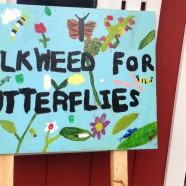
“Engineering is the future, and young people are primed to learn about it,” says Phoebe Ryles, Milton’s Lower School woodworking teacher. “To design and construct, children have to think through steps and decide what should come next. You just need the right project to launch 8-year-olds into this work.” Inspired by a program on cutting-edge engineering curriculum developed by the Museum of Science, Phoebe leveraged the Grade 3 Monarch butterfly unit. Phoebe charged her students with researching, designing, building and installing a 4×8 foot raised planting bed — a butterfly way station. With teachers Jane McGuinness and Susan Wheelwright, third graders learn about the Monarch’s life cycle; they raise butterflies from the caterpillar stage and learn about habitat, diet, and migration patterns.
In recent years, students also learn that Monarch butterflies could become extinct, because their natural habitat is being destroyed. Each year, migrating Monarchs lay their eggs on abundant milkweed. Housing and commercial development, as well as the increasing growth of genetically modified corn, has decreased the wild milkweed. An intercontinental movement is working at placing way stations strategically, at points where the butterflies can feed and lay their eggs. In building their raised-bed way station and planting it with the right flora, Milton students learned that they could help reverse the decline in the Monarch population.
The third graders began by examining other raised beds on campus and asking their own questions: How are they joined at the corners? Are any weak or breaking? What kind of lumber was used? Together, based on their research and experience, the students design what they hypothesize will work. Phoebe walks the children explicitly through the Engineering Design Process — a five-stage course of asking questions and solving problems: Ask, Imagine, Plan, Create, Improve.
 Students build models — several — and then test them. They learn as much from the failed ideas as they do from their success. From drawing plans on paper, they move to cardboard models, to building “to scale” models. Challenges are many, and often unexpected. “We’re problem solving in real time, all the way through,” says Phoebe. “For instance, if we run out of wood, we need to reassess and come up with a new plan. I’m trying to teach the children to be resourceful and think through challenges. I tell them, ‘You made it, so you can fix it.’”
Students build models — several — and then test them. They learn as much from the failed ideas as they do from their success. From drawing plans on paper, they move to cardboard models, to building “to scale” models. Challenges are many, and often unexpected. “We’re problem solving in real time, all the way through,” says Phoebe. “For instance, if we run out of wood, we need to reassess and come up with a new plan. I’m trying to teach the children to be resourceful and think through challenges. I tell them, ‘You made it, so you can fix it.’”
Children rely on concepts of fractions and division — math above their grade level. When the time comes to learn about division, they’re prepared and excited.
“These children gain confidence based on ability,” says Phoebe. “Assembling and installing the raised bed means manipulating — lifting, measuring, cutting — solid 2×12 boards. The students do the lifting on their own! They figure out how to work together, and they feel capable, because they are.”
Students need to apply what they’ve learned of life science (keeping data, forming hypotheses) to this engineering-math-woodworking collaboration. With Spanish teacher Lucia Castineira, students learn the related Spanish vocabulary and test it, connecting via Skype with peers in Mexico — other young people committed to this cause. Students use the Internet program Journey North to track the butterflies’ migration north and south; they keep track of current events; and they artistically express what they’re learning in nature journals.
“We’re focused on extending and connecting lessons throughout the year,” says Grade 3 teacher Jane McGuinness. “Students bring in New York Times articles about the declining Monarch population that they’ve found online with their parents. On top of everything else, they’re using technology well to help with their research.”
“This unit involves many academic skills, but it also appeals to students’ character, persistence, desire to do good,” says Phoebe. “Grit is a top predictor of success, and this is what they’re experiencing. The physicality of woodworking makes it appealing and tangible. Creating a concrete, practical product makes this learning real for them. Students love helping a creature they’ve come to care about. We’re helping them develop great habits — being good citizens, communicating, compromising productively, and persevering in the face of challenge.
by Erin Berg



